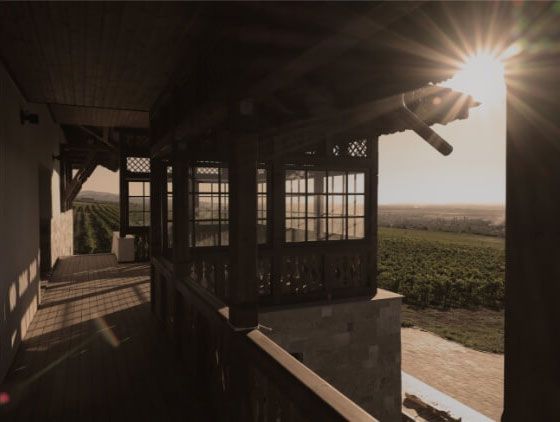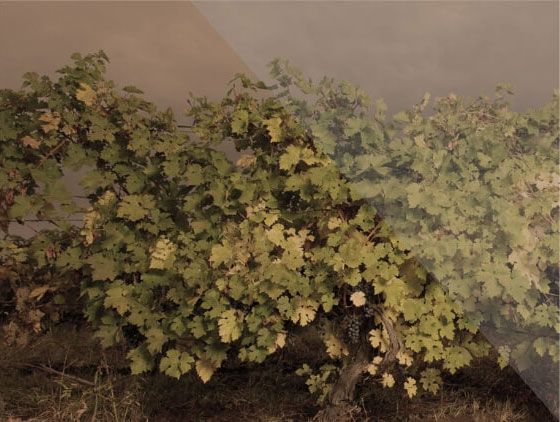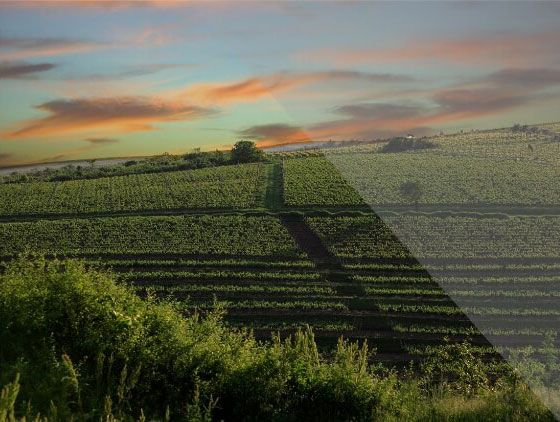
EXPERIENCE
Working on our soils
When we begin working on the soils that feed our vines we intentionally employ traditional methods, even if we use state of the art technology, with ever increasing efficiency.We prefer to work harder, several time a year, by ploughing rather than using herbicides to control weeds in our vineyards. Moreover, ploughing aids in aerating the soil, which favors microbiological development – an important factor in natural equilibrium of each plot. Ploughing also limits water evaporation, crucial during prolonged droughts.Difficult and poor soils like the ones in our vineyard have the reputation of being ideal for a qualitative production. However, it is necessary to avoid instances when soil nutrients reach critically low levels so as not to excessivelt weaken our vines. This is why we use natural fertilizer, manure, which adds enough nutrients to our soils, while also aiding with water retention.
EXPERIENCE
Pruning
Pruning is essential for both obtaining high quality grapes and for ensuring the longevity of our plantations. Superficial pruning can lead to surpluses during harvest, with grapes that are nut fully ripe. On the other hand, excessive pruning may cause our vines to strengthen too much, encouraging growth rather than ripening the grapes. Effective pruning, influenced not only by each plot, but also by every grape variety, requires reaching a fine balance that can only be achieved after years of experience.
EXPERIENCE
Spring
During springtime we focus on activities that will assure optimal conditions for the development and ripening of our grapes.By weeding out we partially remove buds from their strains in an attempt to control vegetative growth, which would limit the exposure of future grape clusters to sunlight and at the same time slow the diffusion of nutrients from leaves to grapes. By trellising we aim to maximize the surface of every leaf exposed to sunlight while also minimizing tangling of branches (which creats a friendly environment for fungus). This operation also helps us to expose as many grape clusters as possible to sunlight and also creates the spaces needed for airflows to dry the vineyards after periods of rain in order to reduce the risks of fungus diseases and other vineyard specific diseases.
Obtaining perfectly ripe grapes ensues a perfect control of phito-sanitary conditions in the vineyards.Due technical progress made in this area, all fungal diseases are kept under control using only organic substances, and because of our planting and pruning techniques, which help maintaining a dry environment we have managed to drastically reduce the risk of rot.
EXPERIENCE
Thinning and Yield Management
Yield management is a key factor that plays an important role in the quality of grapes and of the wine subsequently obtained. A large production (expressed as kilos per hectare) will not reach an excellent ripening state because the vines cannot fully nurture every grape. Even though no legal limits exist in Romania regarding maximum production per hectare, we have decided to implement yield management as a strict practice in our vineyrards, sacrificing a large production for the highest quality attainable.
By thinning we eliminate certain grape clusters from our vines, right before the beginning of the ripening period. By doing this we encourage a better concentration of aromas in the remaining grapes and at the same time begin a first qualitative selection – we can eliminate clusters that are not well positioned or that are lagging behind in terms of ripeness. It is very meticulous work, that we do grape by grape for every plot and every variety in our vineyards.
EXPERIENCE
Harvest
Before beginning the actual harvesting process we first analyse every variety, checking sugar and acidity, feeling the pulp and tannins of our grapes.We often risk the chance of rain from the looming clouds above us in our attempt to harvest perfect grapes. We always harvest using the same local people who return year after year, benefitting from their knowledge and ability to start sorting our grapes from the vineyard.
We always start with Feteasca Alba, followed by Riesling Italico and Sauvignon Blanc, usually from the end of August to the end of September. We continue with FeteascaNeagra, Merlot and in the end always Cabernet Sauvignon, from our oldest vines – over 50 years old, at the end of October, sometimes even in the beginning of November.
Once in the winery the grapes go through a third sorting process, on a fixed sorting table, where we make sure that only the perfect grapes reach our tanks and press.
EXPERIENCE
Fermentation, Oak Ageing and Bottling and Ageing
After sorting, grapes take different paths, depending on the type of wine we intend to make. White varities reach the press, while red varieties after being crushed go straight to stainless steel tanks, where under gravitation force the free-run juice is obtained - it is from this juice that we produce our Davino red wines. The alcoholic fermentation for both reds and white takes place at strictly controlled temperatures in special stainless steel tanks that allow us to use separate winemaking for each plot and each variety. For our reds, the malolactic fermentation takes place immediately after the alcoholic one.
Part of our whites and all of our red wine, after their fermentation, are aged in Romanian oak barrels.Years of experience have taught us to use different types of wood and different types of cask burns, to obtain a perfect balance and to underline the unique character of Ceptura’sterroir.
Our wines are bottled using a state of the art automated line, under strict conditions, ensuring a minimum impact on the wine, while adhering to the tightest quality and sanitary conditions. After being sealed, always with natural corks, our Davino wines begin their bottle aging process, waiting to get closer to the optimum drinking period. Our red wines are bottle aged for a minimum of 30 months.
EXPERIENTA
Etichetare si Livrare
Ultimul pas din acest proces de creatie presupune etichetarea si impachetarea fiecarei butelii. Daca etichetarea se face automat, impachetarea presupune o ultima verificare a fiecarei sticle DAVINO inainte de iesi din crama: fiecare butelie este verificata si infasurata cu o foaie de hartie subtire, care protejeaza sticla si eticheta pe parcursul transportului, pana cand ajunge in fata dumneavoastra.

 WINES
WINES




